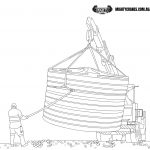
What is Luffing and Slewing?
In the world of construction and heavy lifting, cranes play a pivotal role in making the seemingly impossible tasks possible. To operate these mechanical giants safely and efficiently, it’s crucial to understand two fundamental concepts: luffing and slewing. In this article, we’ll delve into the basics of luffing and slewing in cranes, shedding light on their significance and how they work together to ensure precise and secure operations.
Luffing in Cranes
Luffing, in the context of cranes, refers to the vertical movement of the load and the control of the hook’s height. This movement is essential when dealing with tasks that require raising or lowering materials with precision. Several types of cranes use luffing to get the job done, with tower cranes and ship cranes being common examples.
Key components involved in luffing include the luffing jib and the luffing winch. The luffing jib is the part of the crane that extends or retracts to control the hook’s height. The luffing winch, on the other hand, is responsible for winding or unwinding the cable attached to the load.
Achieving precision in luffing operations involves careful load control and accounting for wind resistance. Crane operators must delicately adjust the luffing mechanism to ensure the load doesn’t sway excessively or become unstable. Moreover, windy conditions can challenge the operator’s ability to maintain a steady luffing process.
Safety is paramount when it comes to luffing. Operators must be acutely aware of the crane’s load capacity and adhere to it strictly to prevent overloading. Additionally, they need to be vigilant to avoid collisions with structures, equipment, or other workers on the job site.
Slewing in Cranes
Slewing is another crucial crane operation that focuses on the horizontal movement of the load and the rotation of the crane’s superstructure. This movement is indispensable when it comes to positioning the load accurately. Crawler cranes and mobile cranes are examples of crane types that heavily rely on slewing.
Key components involved in slewing include the slewing ring and the slewing motor. The slewing ring acts as the pivot point for the crane’s superstructure, allowing it to rotate smoothly. The slewing motor provides the power needed to initiate and control this rotation.
Slewing, like luffing, demands precision. Operators must be able to place the load exactly where it needs to be, whether it’s lifting heavy materials onto a building or maneuvering equipment in a shipyard. Coordination between luffing and slewing is essential to achieve the desired accuracy.
Safety considerations during slewing operations primarily revolve around clearing obstacles. The operator must ensure that the path of the load is clear of any obstructions or potential hazards. Additionally, slewing operations must be executed by trained and certified operators to prevent accidents.
Coordination between Luffing and Slewing
While luffing and slewing are distinct crane operations, they often work together seamlessly to accomplish complex tasks. Consider the construction of a tall building, for instance. Luffing raises the materials to the required height, while slewing positions them precisely where they are needed. This coordination requires skilled operators who can synchronize these movements effectively.
In shipyards, crane operators use luffing and slewing in tandem to transport heavy cargo onto vessels. The load is first luffed to the appropriate height and then slewed horizontally to the precise location on the ship’s deck. This teamwork ensures that the cargo is loaded securely and accurately.
Luffing and slewing are fundamental concepts in crane operations, and they go hand in hand to achieve precision and safety. Skilled operators play a vital role in synchronizing these movements, making it possible to complete intricate tasks in construction and heavy lifting. As crane technology continues to advance, the importance of safety and ongoing training for operators remains paramount. With a clear understanding of luffing and slewing, we can appreciate the intricacies of crane operations and the professionals who make them happen safely and efficiently.
References
Safety and safe conditions for crane operation
https://www.safeworkaustralia.gov.au/system/files/documents/1703/general-guide-for-cranes.pdf
Slewing Cranes
https://mightycranes.com.au/what-is-a-slewing-crane/
Luffing




